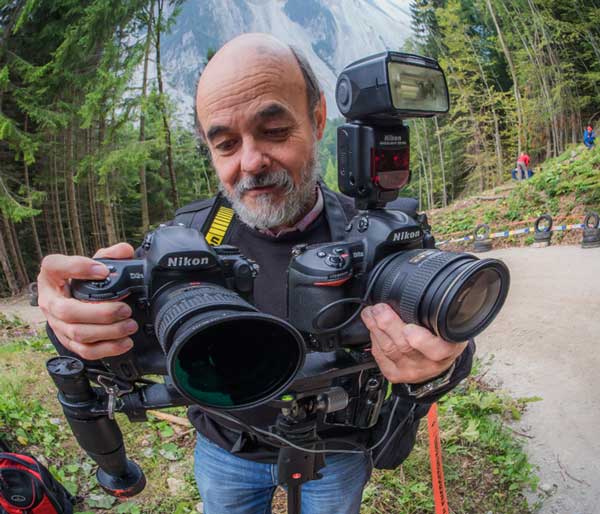Contests

Photographer of the week: Milan Malovrh
1x Blog ContestsMilan Malovrh is a highly appreciated artist photographer. He is well known for his artistic motion you can see in his work. The world through his camera is amazing. No matter what the subject is, he always succeed to put his personal approach in each and every image. Let's listen to his story and discover more about him.

I have been interested and involved in photography my entire life. I belong to the generation that barely caught the transition from analog to digital. My first contacts with photography started back in primary school when a group of us had a mentor who was an artistic photo/art enthusiast. He showed us the views and techniques of that time.
I was born in Tržič, a town in Slovenia which was at that time part of Yugoslavia and where my later exhibitions took place. After finishing a technical orientated high school I worked for a decade as a film production coworker for a national television channel on events of a documentary genre and as an author of amateur short films. At the decline of video technology and the transition to film, I gave up and continued more seriously in photography.
At the time of analogue photograph I was using my photography club’s photo lab. I participated in group exhibitions, organized club events and later a few independent exhibitions. Themes at that time were more or less opportunistic. Above all, sports topics in which experimentation had a strong presence, despite the limitations of the materials. I was also interested in landscape and concert photography.
After the transition to digital photography, the conditions and possibilities changed drastically. I continued with experimentation in sports photography and spread that to most of the themes that I have practiced. In the beginning. I was using filters in Photoshop, but gave that up later. I advocate that most of the pictures taken happen at the moment of firing the camera and not later with various presets and digital processing.



What I admire? Maybe the beauty of the horse or the energy, which occurs at a gallop. Or a sportsman having the lead. Or the anticipated destruction of Venice. These are the feelings, impressions at the time of the creation of my photos.
Locations are a lot of times random. Sport photography requires accreditation most of the times. Likewise, in horse photography: the owner is responsible for the safety and will not permit a lot. But yes, I do have a few locations where I can choose time (light conditions) and background on my own, which is essential for a good technical photo and will also yield good shots.
My equipment consists of Nikon D3s and the older D3x. Fortunately, Nikon cameras have had useful multiple exposure for many years, unlike the competition. My lenses: Two 24mm-120mm, 70-200mm; 500mm; neutral filter as a must, connection cable for simultaneous actuation and some home-made equipment: eccentric vibrator, a console for two focused cameras.
First I was using a zoom lens shooting the horses, later I started using movement of the camera and horses with longer exposure time. I also want to present horses with multi exposure time with one camera, and ultimately with two cameras. My goal is to abstractly present the animal's movement without any later treatments with Photoshop.
Light is very important for my photography: morning sunlight and dark background are a wish come true and with some luck on the composition the best photos are made in those conditions.
On default the camera is set on auto focus, multiple exposures to three shots per minute, time 1/10 seconds and a dark neutral filter when following the animal. Due to the lack of sharp parts I use simultaneous shots with the second kit with the same lens and shorter exposure time (1/200 sec). If I don't catch the second shot good enough, I do partial photo merging.
For processing I use Photoshop CS6 and Mystikal TNT plug-in. I deliberately don't use blur.
For best results you should work in low light with a dark background. If you wish you should upgrade two cameras with the same focal length. Direct them to the same point, one in multiple settings and the other for sharp focus. For further upgrade, a particular background in multiplex view and repeated shaking effect, and eccentric vibrator are needed.
I have contacts with photographers around the world, but in our gallery there are quite a few authors whose work I really like. But I’m primarily interested in photographers who use a similar technique to mine. Some authors use digital processing to accomplish the same effect..But this doesn’t attract me.
Equipment that is necessary to achieve the proper effect is actually quite heavy. Weight exceeds 5kg and working with it for an hour or more is tedious and tiring. Wishes for the future are mostly settings on the camera itself. With a variety of adjustable times in multiplex mode, it would require only one camera.
One of my favorite photographs is a portrait of Lipizzaner taken with a single camera, where in spite of prolonged exposure time and multiple two shots, sufficient sharpness was achieved.
1x is the best! The gallery is highly appreciated worldwide.
For me, participation in the gallery greatly contributed to my recognition and I got a lot of worldwide invitations for similar interviews or for publications in various printed publications.
Let me list a few of them:
Photographer, Ukraine
Horsemanship, China
DC photo magazine, Hong Kong
Photographer companion, China
Digital photo, England
Digitalna fotografija, Slovenia.
The 1x gallery is highly appreciated in Slovenia with already established authors, and especially among young people. Just the admission to the gallery is a powerful incentive and reward.







